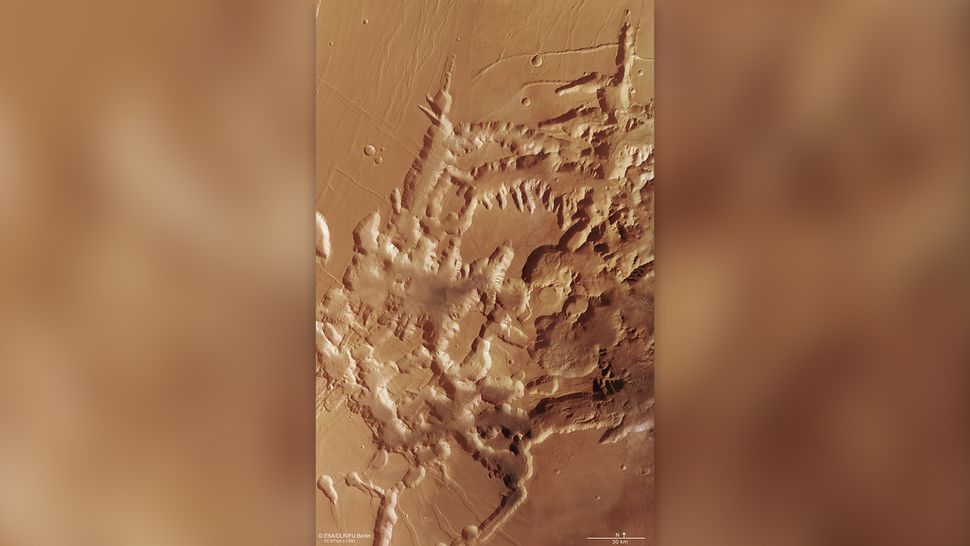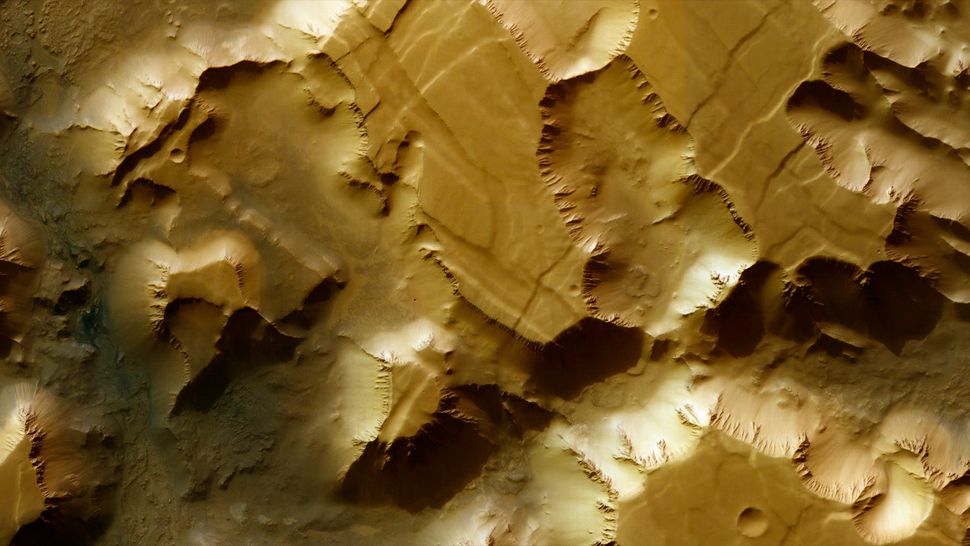Science
Related: About this forumSpace photo of the week: Ancient 'labyrinth of night' on Mars, one of the biggest mazes in the solar system
By Jamie Carter published 3 days ago
Take a trip through the maze-like valleys and canyons of a unique place in the solar system: Mars' 'labyrinth of night.'

Noctis Labyrinthus, as seen by Mars Express.
Noctis Labyrinthus, as seen by Mars Express. (Image credit: ESA/DLR/FU Berlin, CC BY-SA 3.0 IGO)
What it is: A rift valley called Noctis Labyrinthus ("labyrinth of night"![]()
When it was released: Jan. 24, 2024
Where it is: Between Valles Marineris and Tharsis on Mars
Why it's so special: Noctis Labyrinthus is unlike anywhere else in the solar system. Around 739 miles (1,190 kilometers) long, 19 miles (30 km) wide and 4 miles (6 km) deep, it's a rift valley region of Mars studded with sand dunes, canyons and landslides.
A new labeled and zoomable image published this week by the European Space Agency (ESA) comes from data collected by ESA's Mars Express spacecraft, which has been orbiting the Red Planet since December 2003. In October 2023, ESA released a flyover video of the same region that used images from Mars Express and topographic data to recreate the landscape in 3D.
In the new image, the original ground level can still be seen, though much of the ground has eroded. That's because volcanism has caused the surface to stretch upward, thinning the planet's crust and forming cracks.
Noctis Labyrinthus is between the western edge of Valles Marineris, an extensive canyon system known as the "Grand Canyon" of Mars, and Tharsis, the largest volcanic region on Mars, which contains 12 large volcanoes.
More:
https://www.livescience.com/space/mars/space-photo-of-the-week-ancient-labyrinth-of-night-on-mars-one-of-the-biggest-mazes-in-the-solar-system
~ ~ ~
Soar through the 'Labyrinth of Night' — a Martian canyon the size of Italy — in thrilling new satellite video
News
By Briley Lewis published October 18, 2023
See Mars' geology up close, thanks to decades of stunning images from the Mars Express satellite, in a new visualization of Noctis Labyrinthus, the 'Labyrinth of Night'.

This mosaic shows part of the Noctis Labyrinthus region, the ‘Labyrinth of the Night’, on Mars. (Image credit: ESA/DLR/FU Berlin (G. Neukum). Image mosaic assembled by Bill Dunford.)
A thrilling new video lets viewers fly through Mars' enormous "Labyrinth of Night," a system of extremely steep valleys about the length of Italy.
The criss-crossing valleys in Noctis Labyrinthus, which is Latin for "Labyrinth of Night," are up to 19 miles (30 kilometers) wide — a bit longer than Manhattan — and 5 miles (6 km) deep. In the video, released by the European Space Agency (ESA), you can also spot craters, the wreckage from huge landslides, and dunes from blowing sand.
The video also shows curious geologic features called grabens, which are a sign of plate tectonics. These "stretch marks" are parts of the Martian crust that have been stressed and cracked due to volcanic activity, ESA officials said in a statement.
More:
https://www.livescience.com/space/mars/soar-through-the-labyrinth-of-night-a-martian-canyon-the-size-of-italy-in-thrilling-new-satellite-video
et tu
(1,883 posts)but i didn't see 1 greenie, lol
2naSalit
(92,690 posts)Thanks for posting this! ![]()
I took a class on the geology of the planets when I was in college. Though I don't recall much detail from the class I did retain some interest in the subject. This is fascinating!
lastlib
(24,905 posts)I f***in' love science! The science deniers/religious wackos et al. just don't know what they're missing! So much beauty in our universe, yet they refuse to see the truth.